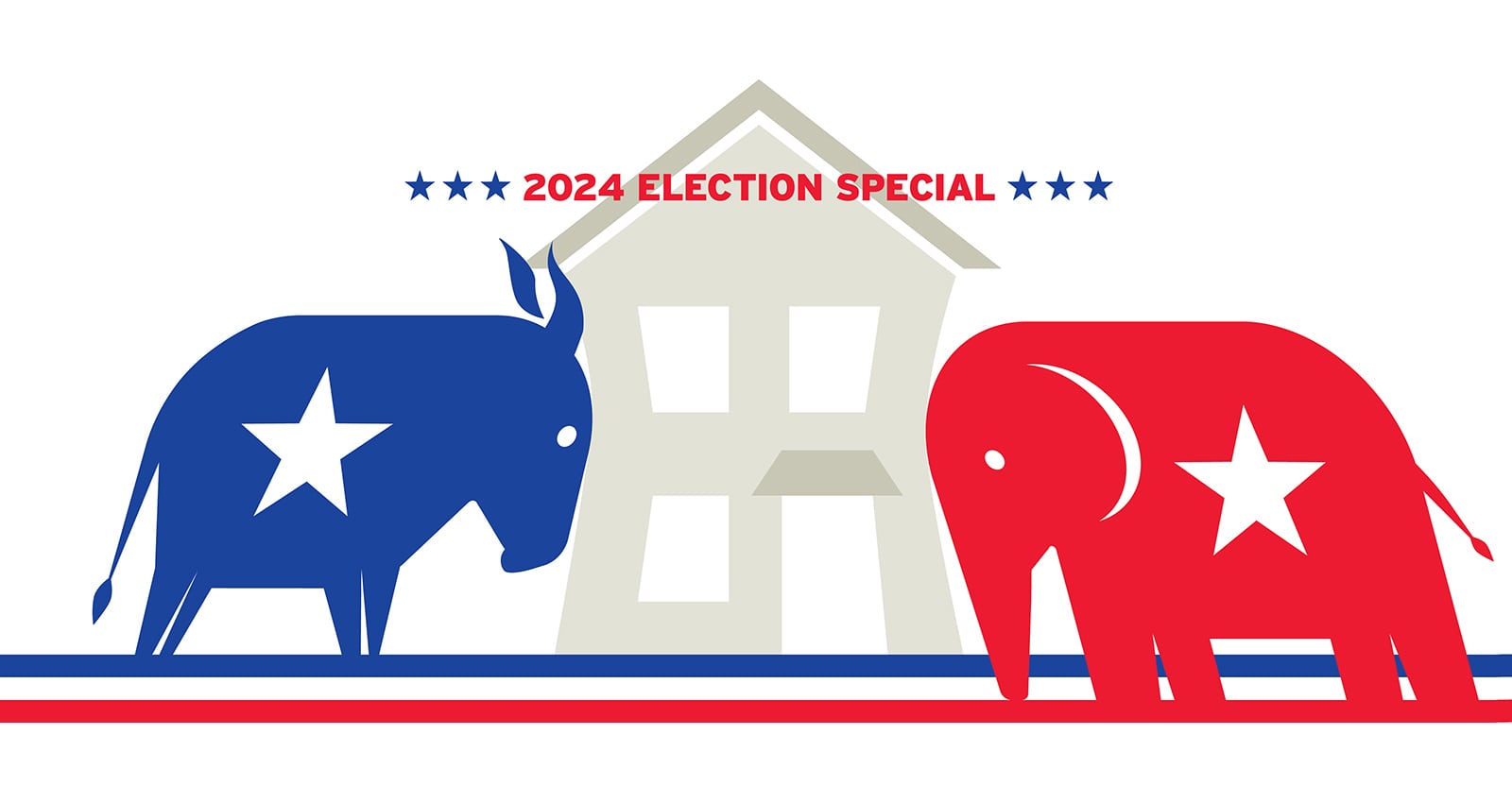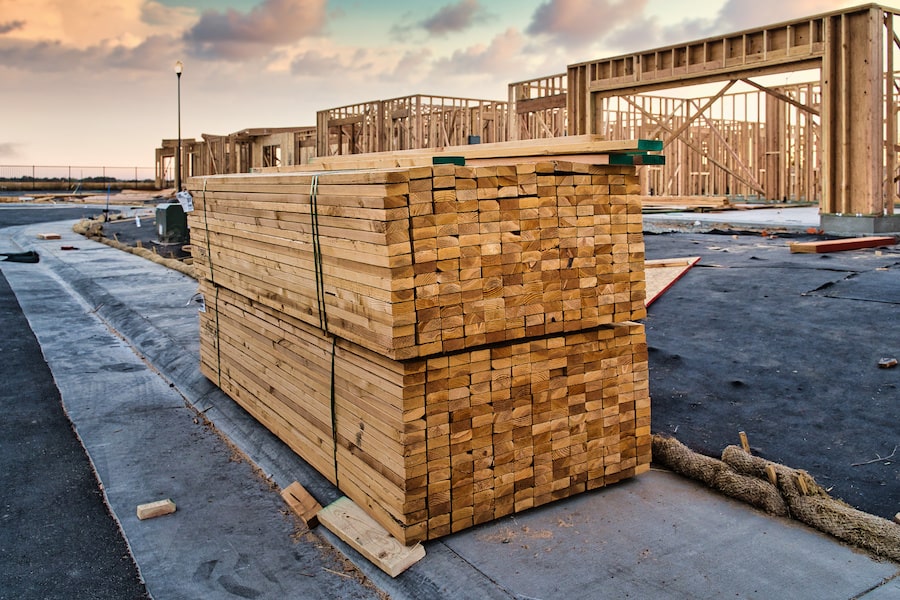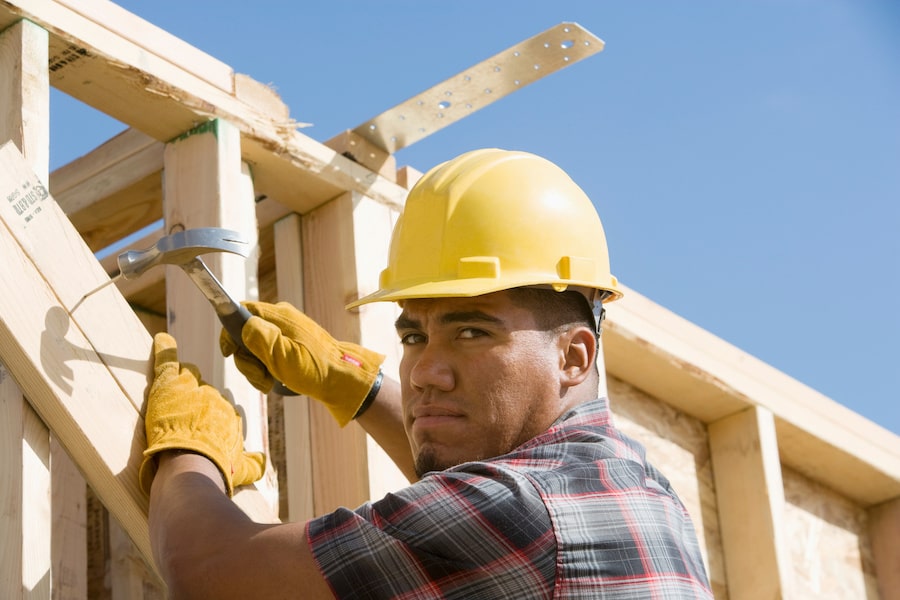Don’t look now, but housing is at the center of political debate leading up to the 2024 presidential election. Given the importance of the housing industry to the nation’s economic well-being—representing up to 13% of gross domestic product—it’s a bit surprising that housing rarely is the focal point of federal![]() political policies or campaign rhetoric. But not this year. In 2024, the combination of inflation, housing affordability, housing supply, and increased regulations has created a witches' brew of issues attracting the attention of voters and has pushed housing to the center of the political stage.
political policies or campaign rhetoric. But not this year. In 2024, the combination of inflation, housing affordability, housing supply, and increased regulations has created a witches' brew of issues attracting the attention of voters and has pushed housing to the center of the political stage.
Housing problems are often complex, with many factors at play, but ultimately the issue boils down to just two sides of the same coin: affordability and inventory.
Historically, Democrats have advocated for a stronger government role in tackling housing affordability while Republicans generally prefer market-based solutions. Each party’s platform for this election cycle is no different.
Regulations
This summer, the National Association of Home Builders (NAHB) unveiled a 10-point plan to address the housing affordability crisis by refilling the pool of skilled construction labor, easing financing for developers, and expanding housing supply.
But the biggest barrier to housing affordability, says Lake Coulson, NAHB’s SVP of government affairs and the association’s chief lobbyist, is the impact regulations have on costs and pricing. “Residential construction is one of the most heavily regulated industries in the country,” Coulson says, citing a 2021 NAHB study, which estimated that roughly 24% of the price of a new, for-sale single-family home—equating to more than $93,000 at that time—is tied to regulatory compliance.
With an independent Federal Reserve, the White House has little sway over interest rates. But the GOP believes that the executive branch should have more control over the Fed, or at least should pick up the pressure Trump placed on that body during his time in office.
With an independent Federal Reserve, the White House has little sway over interest rates, but the GOP is of the mind that the executive branch should indeed have more control over the Fed, or at least should pick up the pressure Trump placed on that body during his time in office.
RELATED
- Housing Costs Have Doubled in Swing States Since 2020
- Housing Affordability Becomes Debate Topic in 2024 Presidential Election
- Biden's Proposed Fixes for Housing Affordability
The GOP’s housing platform also opposes broad federal rent-control measures and favors policies that open up federal lands for development and that encourage private-sector solutions. The latter includes tax incentives for developers to build affordable housing in opportunity zones and other low-income communities, a component of Trump’s 2017 tax plan that passed into law.
On the other side of the aisle, the housing plank in the Democratic Party’s platform builds on the Biden administration’s efforts to provide direct assistance to renters and first-time homebuyers.
Key components of that policy are a $10,000 tax credit for first-time buyers, $25,000 down-payment assistance, and expansion of the low-income housing tax credit—all aimed at closing the nation’s wealth gap and increasing access to homeownership for more Americans.
The Democrats also propose a $40 billion “housing innovation fund” to help local governments build more affordable housing, emphasizing rent control and tenant protections to stabilize housing markets and prevent evictions in areas experiencing sharp rent increases.
Renting vs. Owning
As owning a home becomes increasingly unattainable for more Americans, especially younger generations saddled with debt and lower wage growth, the rental market—including the surging single-family build-to-rent and higher-density multifamily sectors—is filling the supply gap.
But within those rental realms, institutional investors are driving up housing costs by cornering the rental market and increasing rents, putting affordable housing beyond the reach of many.
Ivy Zelman, a financial analyst who has covered the housing industry for more than 30 years, says that while such investors account for less than 3% of homeownership, they present a significant problem for renters. “Twenty-three percent of homeowners today spend more than 30% of their annual income on shelter,” she says, citing a common benchmark for housing affordability relating to how “cost burdened” Americans are with regard to paying for housing. But an even higher percentage of renters are above that threshold—the consequence of annual rent increases of 40% to 50% imposed by owners, operators, and investors.
That inequality gap will only get wider, Zelman anticipates, because homeowners benefit from price appreciation while renters do not. “How do you solve that? I don’t know that there’s an easy answer,” she adds.
To help move people into homeownership, Democrats support federal initiatives such as the Neighborhood Homes Investment Act, which provides tax credits for renovating and developing affordable homes in distressed areas. The party also favors zoning reform at the local level to encourage higher-density housing, including multifamily units, as a way to increase supply, reduce prices, and boost ownership.
For the GOP’s part, it also wants to loosen zoning restrictions, especially in dense urban areas.
Tariffs
Each party’s approach to tariffs on imported materials, such as timber, and finished goods differs in the housing affordability conversation. Republicans have advocated for domestic tariffs to increase U.S. manufacturing activity, and the majority of tariffs implemented during the Trump administration were retained by President Biden.
In fact, in August, the current administration nearly doubled the tariff on Canadian lumber imports, much to the chagrin of NAHB, which called on the White House to suspend those tariffs to improve housing affordability.
The GOP platform proposes additional tariff hikes if it reclaims the White House. The Tax Foundation, an independent, nonpartisan policy analysis organization, estimates the cost of those increases would raise domestic taxes by $524 billion annually and shrink the nation’s GDP by at least 0.8%.
Housing Supply
While high interest rates, burdensome regulations costs, rental property consolidation, and import tariffs all contribute to the housing affordability crisis, almost everyone agrees that the simple law of supply and demand is a primary cause.
Estimates differ among economists and policy wonks, but the sweet spot seems to be 3 million to 5 million housing units needed to keep up with household creation.
“Housing on the supply side is essentially maxed out,” says Michael Guckes, chief economist at ConstructConnect, a construction information and technology solutions company. “It continues to operate at the edge of its capacity, and the $25,000 subsidy proposed by the Democrats doesn’t solve that problem.”
Also, federal policies are limited in their effectiveness if state and municipal governments aren’t willing to make changes to help increase housing supply. “We need people at every level of government to address the factors limiting production,” says Rosemarie Hepner, VP at the Urban Land Institute’s Terwilliger Center for Housing. Those factors include restrictive zoning and burdensome regulations that dictate housing type and density, processes that add time and costs to projects, NIMBYism (not in my back yard) that derails projects and discourages production, and financial hurdles such as the rising costs of land, labor, and materials.
The GOP has not put forth a specific plan to address the housing affordability issue, per se, but instead points to a centerpiece of its campaign that it says will resolve the housing shortage: the mass deportation of 15 million to 20 million undocumented immigrants.
Pew Research Center, a nonpartisan think tank, using 2022 data, estimates that unauthorized immigrants live in 6.3 million households that include more than 22 million people—roughly 5% of the 130 million U.S. households at that time. And about 70% of those households include people who are lawful immigrants or U.S.-born residents. Some economists stress that a mass deportation of some 15 million people would not, in fact, free up nearly enough housing to solve the current supply problem.
Skilled Labor
Mass deportation of immigrants would also exacerbate a chronic problem facing the housing industry: the shortage of skilled labor.
According to NAHB, about 25% of construction workers are immigrants, while 31% of tradespeople are classified as such. In California and Texas, which combined accounted for about 10% of all new-home completions in 2023, 40% of construction workers are immigrants.
With that, according to NAHB, the spike in immigration since 2022 alleviated some of the labor shortage in those states. “If everything else stays the same—the size of homes people want, the amount of available land, and those kinds of characteristics of demand—labor is probably the biggest hurdle to have to overcome,” Guckes says.
Addressing the labor shortage is one of the 10 points in NAHB’s plan to resolve housing affordability, but most of the points address the need to reduce the number of regulatory compliance issues that prevent builders from increasing capacity because, whether it’s zoning restrictions or permitting blockades, regulations are hampering builders from producing more, and, as a result, reducing the prices of homes.
When it comes to the topic of code compliance and its effect on housing costs, “Perhaps the most important issue before us right now is complying with the rule issued earlier this year that will require all new homes and new mortgages issued by HUD [Department of Housing and Urban Development] and USDA [U.S. Department of Agriculture] to meet the 2021 International Energy Conservation Code,” says Coulson, an edict that could add $30,000 to the cost of a new home funded by those agencies, according to estimates by the Kansas City Home Builders Association.
If the adage that “all housing is local” is true, it tracks that even though we refer to a national housing industry, the fact is that local markets mostly act independently. “The housing situation varies from state to state and city to city,” Hepner says, “so the solutions to resolve it must differ accordingly.”
In fact, some cities and states have made great strides in implementing viable solutions to promote and attain more affordable housing stock. These include Florida’s Live Local Act, Montana’s bipartisan policies, and Boise’s zoning overhaul, among several other examples.
“Ultimately, if the federal government can help address the housing crisis by coming up with ways to incentivize local production, then communities might feel encouraged to implement policies and new, innovative solutions for the benefit of us all,” he says.
The question for voters—especially those involved in the housing industry—this fall is whether either of the parties’ proposed policies will move the needle on the housing affordability problem.
Paul Deffenbaugh is a former contractor and an award-winning journalist who has been writing about the construction industry for more than 25 years. He can be reached at paul@deepbrookmedia.com.









